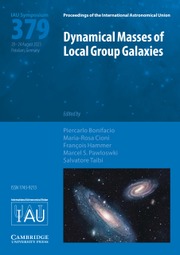No CrossRef data available.
Article contents
Linking star formation and galaxy kinematics in the massive clusterAbell 2163
Published online by Cambridge University Press: 09 February 2015
Abstract
The origin of the morphology-density relation is still an open question in galaxyevolution. It is most likely driven by the combination of the efficient starformation in the highest peaks of the mass distribution athigh-z and the transformation by environmental processes atlater times as galaxies fall into more massive halos. To gain additionalinsights about these processes we study the kinematics, star formation andstructural properties of galaxies in Abell 2163 a very massive(~4×1015 M⊙, Holz &Perlmutter 2012) merging cluster atz = 0.2.
We use high resolution spectroscopy with VLT/VIMOS to derive rotation curves anddynamical masses for galaxies that show regular kinematics. Galaxies that showirregular rotation are also analysed to study the origin of their distortion.This information is combined with stellar masses and structural parametersobtained from high quality CFHT imaging. From narrow band photometry (2.2m/WFI),centered on the redshifted Hα line, we obtain star formation rates.
Although our sample is still small, field and cluster galaxies lie in a similarTully-Fisher relation as local galaxies. Controlling by additional parameterslike SFRs or bulge-to-disk ratio do not affect this result. We find however that~50% of the cluster galaxies display irregular kinematics in contrast to what isfound in the field at similar redshifts (~30%, Böhm et al.2004) and in agreement with otherstudies in clusters (e.g. Bösch et al.2013, Kutdemir et al.2010) which points out to additionalprocesses operating in clusters that distort the galaxy kinematics.
Information
- Type
- Contributed Papers
- Information
- Proceedings of the International Astronomical Union , Volume 10 , Issue S309: Galaxies in 3D across the Universe , July 2014 , pp. 330
- Copyright
- Copyright © International Astronomical Union 2015

